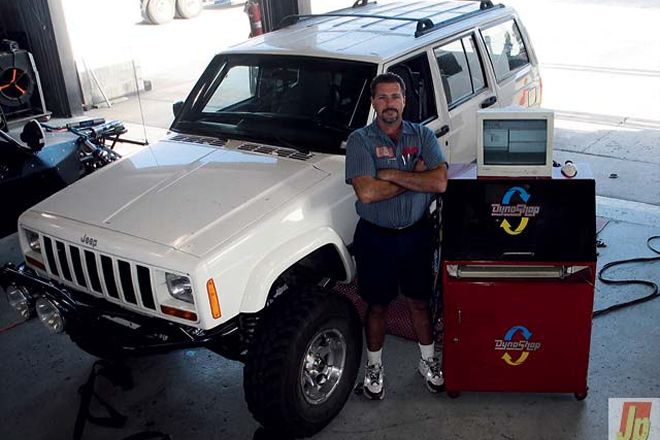
 Christian Hazel
Brand Manager, Four Wheeler
Christian Hazel
Brand Manager, Four Wheeler
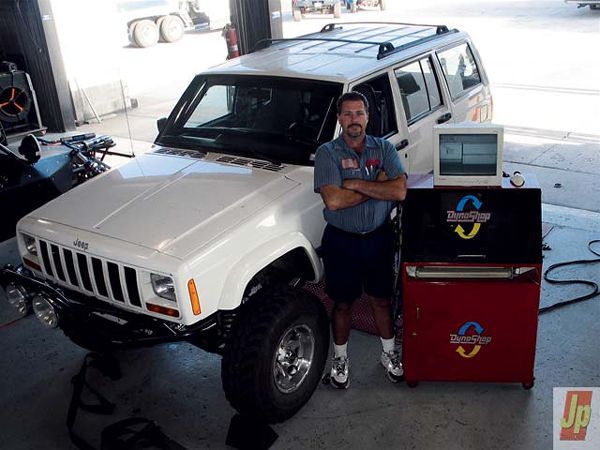
The Insane Inline, Part 1
The Insane Inline, Part 2
The Insane Inline, Part 3
If you tuned in last issue drooling to see the final installment of our Golen Engine Service 4.6L stroker swap, all we can say is sorry. It's pretty common for magazine writers to have the occasional story go completely awry, but this author had three stories in one issue disintegrate into a series of setbacks. Rather than half-ass the final part of this story and leave you with unanswered questions, we decided to kick the story back an issue so we could have the vehicle properly tuned, smog tested, and dyno'd. Unfortunately, the G-Tech performance meter we had hoped to use to give you some 1/4-mile times was on severe backorder, so those numbers will have to wait for another day.
Turbo City Tune After getting the new stroker installed into the engine bay, we fired it up, checked for leaks, double checked the coolant level, and took it for a blast down the road. Even with 91-octane fuel in the tank, there was severe knocking upon mildly hard acceleration. Full throttle use was out of the question. The stock 19 lb/hr injectors just weren't capable of supplying enough fuel to feed the extra cubes and the engine seemed a bit lazy out of the hole.Rather than fumble for our asses in a dark room with both hands, we took our 1999 XJ to Turbo City in Orange, California, to have the fuel injection experts tell us what we needed to do. Turbo City has a vast amount of experience with fuel injection systems and really goes the extra mile to provide the customer with top-quality work. For example, rather than sending us packing when we unknowingly dropped off our XJ with a cracked and leaking header, the guys tore it off, welded it up, and reinstalled it without a whimper.
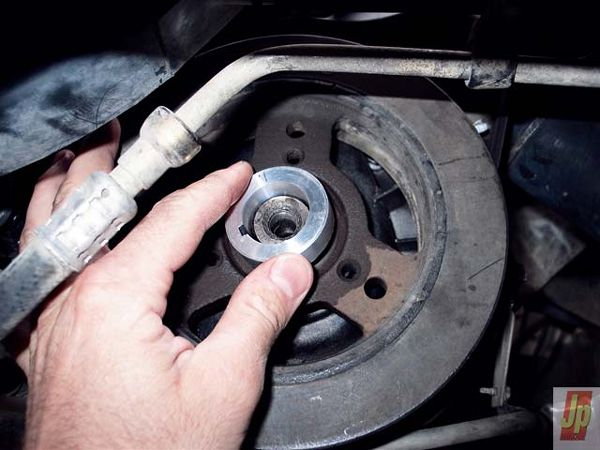 Before we did anything, we needed to address a slight issue with our crank pulley. The 4.2L crank used in the stroker buildup is a long-nose crank, while the stock 4.0L crank is a short-nose crank. As a result, our crank pulley/harmonic balancer wouldn't line up with the other pulleys. We bought this machined aluminum crank pulley spacer from Hesco, which allowed our 4.0L harmonic balancer to fully seat onto the crank and bring the pulleys into alignment.
Before we did anything, we needed to address a slight issue with our crank pulley. The 4.2L crank used in the stroker buildup is a long-nose crank, while the stock 4.0L crank is a short-nose crank. As a result, our crank pulley/harmonic balancer wouldn't line up with the other pulleys. We bought this machined aluminum crank pulley spacer from Hesco, which allowed our 4.0L harmonic balancer to fully seat onto the crank and bring the pulleys into alignment.
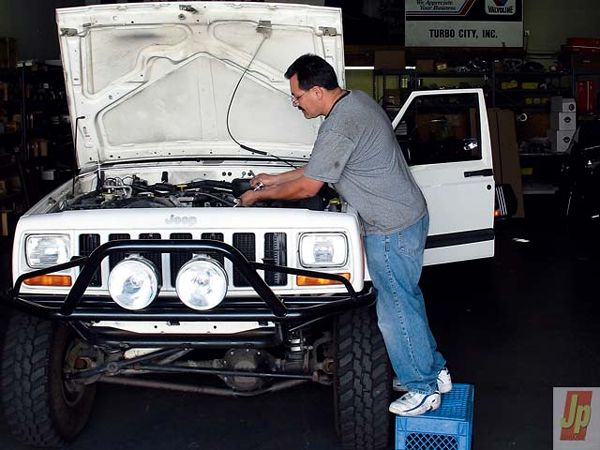 The guys at Turbo City have been working on sophisticated fuel systems seemingly forever. The company is intimately familiar with the fuel systems of both old and new Jeep vehicles and was able to diagnose and fix several trouble areas with our XJ, beginning with a severely cracked header.
The guys at Turbo City have been working on sophisticated fuel systems seemingly forever. The company is intimately familiar with the fuel systems of both old and new Jeep vehicles and was able to diagnose and fix several trouble areas with our XJ, beginning with a severely cracked header.
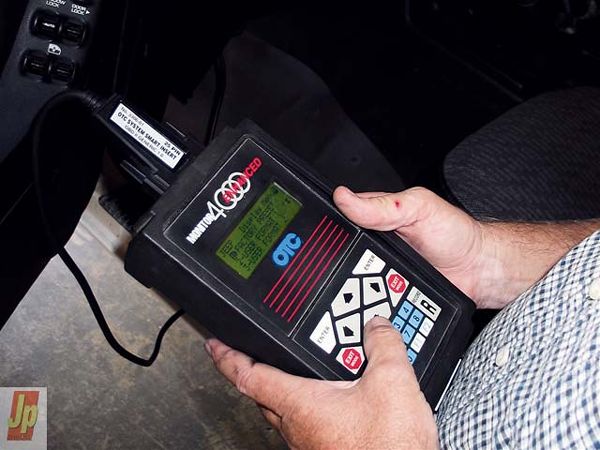 The cracked header was throwing off the O2 sensor. Many shops would have sent us elsewhere to have it fixed, but Turbo City removed and welded our header, then interfaced with the OBDII computer to determine exactly what was going on with the fuel system.
The cracked header was throwing off the O2 sensor. Many shops would have sent us elsewhere to have it fixed, but Turbo City removed and welded our header, then interfaced with the OBDII computer to determine exactly what was going on with the fuel system.
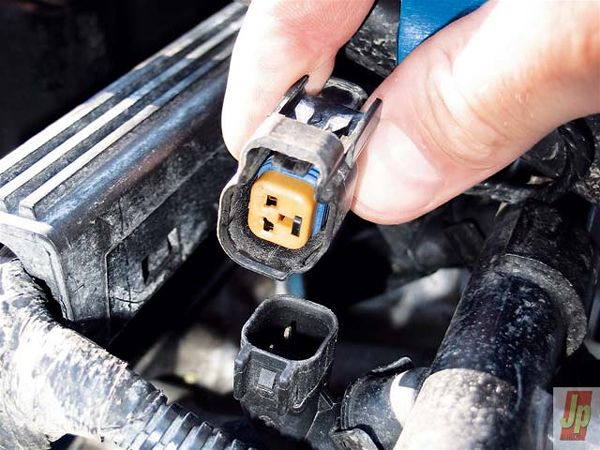 Although the calculations Tom Miller at Turbo City made called for 21 lb/hr injectors, we stepped up to some Accel 24 lb/hr injectors since these engines notoriously run lean and to support any future performance modifications we may make. However, before swapping injectors, Turbo City needed to change our late-model injector harness connectors (shown) to the earlier Bosch style.
Although the calculations Tom Miller at Turbo City made called for 21 lb/hr injectors, we stepped up to some Accel 24 lb/hr injectors since these engines notoriously run lean and to support any future performance modifications we may make. However, before swapping injectors, Turbo City needed to change our late-model injector harness connectors (shown) to the earlier Bosch style.
Although our OBDII computer basically wants to do what it wants to do and Turbo City said the correct way to dial in our system was to reflash the computer, we asked that they just put the scan tool to our system to see where they could go with the factory settings. After replacing the fuel injectors with larger Accel 24 lb/hr parts, they modified our crank position sensor to advance the ignition timing 3 degrees. With their modifications complete, another scan revealed that our fuel system was pulling back fuel both at idle and during normal cruise, trying to get the air/fuel ratio down to a lean 15:1. However, under acceleration the computer was allowing more fuel, with air/fuel ratios back to stock levels of 13:1 or richer. Compared to how lean our engine used to run with the stock 4.0L and our modifications (see Sidebar, Power Play) the fatter fuel curve on our stroker as dialed in by Turbo City nearly mirrored that of our unmodified 4.0L. Although the fatter air/fuel ratio we're running is most likely costing a bit of power, there's no pinging even with 89-octane fuel and full-throttle blasts.
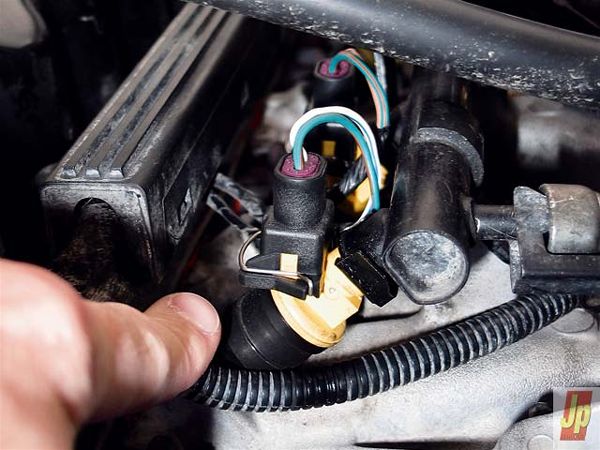 The Bosch-style connector is what all 1998-earlier and some early 1999 Jeeps, as well as Ford vehicles use and Turbo City had a good supply of them in stock. The Accel injectors are truly high-quality pieces that deliver their advertised flow rating, along with excellent fuel atomization for better economy and throttle response. The injectors are an anti-plugging type, which means they eliminate problems associated with carbon build up.
The Bosch-style connector is what all 1998-earlier and some early 1999 Jeeps, as well as Ford vehicles use and Turbo City had a good supply of them in stock. The Accel injectors are truly high-quality pieces that deliver their advertised flow rating, along with excellent fuel atomization for better economy and throttle response. The injectors are an anti-plugging type, which means they eliminate problems associated with carbon build up.
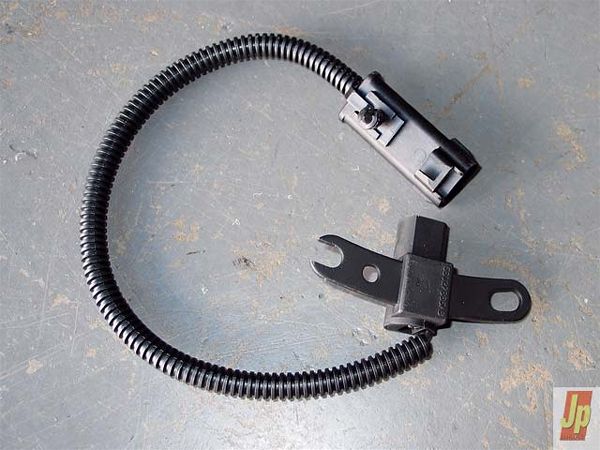 To get some more snap in the bottom end, Turbo City offers its adjustable crank position sensor, PN 635-460 we advanced our timing 3 degrees. The modification increased our throttle response off idle big time.
To get some more snap in the bottom end, Turbo City offers its adjustable crank position sensor, PN 635-460 we advanced our timing 3 degrees. The modification increased our throttle response off idle big time.
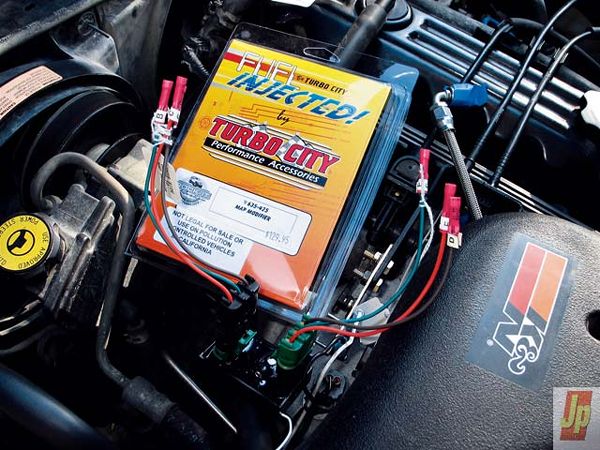 The 24 lb/hr Accel injectors proved a nearly perfect match for our engine. Turbo City installed its adjustable MAP sensor, PN 635-425, but removed it once determining our OBD II engine didn't need it. In all likelihood, an older OBD I system would benefit from the unit's adjustability of the fuel map.
The 24 lb/hr Accel injectors proved a nearly perfect match for our engine. Turbo City installed its adjustable MAP sensor, PN 635-425, but removed it once determining our OBD II engine didn't need it. In all likelihood, an older OBD I system would benefit from the unit's adjustability of the fuel map.
Power Play
For our chassis dyno numbers we revisited The Dyno Shop in Santee, California. Owner Mark MacNeil and the rest of the gang have forgotten more about diagnosing, modifying, measuring, and extracting power from vehicles ranging from $100K turbo Porsches to carbureted dune buggies than we'll ever know. The Dyno Shop baselined our XJ back when it was stock and when we added our Gibson header and exhaust, K&N FIPK air intake, Performance Distributors Firepower Ignition Kit, Rubicon Express 62mm throttle body, and Hypertech Power Programmer (although the stroker uses factory computer calibrations).
MacNeil says our horsepower levels could be brought up quite a bit more with some computer tweaking and some leaning of the air/fuel curve. We were nervous about dinging our new engine, so we purposefully jetted our NOS nitrous system too rich. We're considering adding a larger 66mm throttle body down the road to get some more air into the engine and may tweak the computer, but for now we're happy with the added power across the entire rpm range without worrying about knocking or harming the engine.
Even though we've been experimenting with 89- and 87-octane fuel, all of our dyno testing was performed with 91-octane premium pump gas.
Test 1:
Bone Stock 4.0L
RPM: Power: Torque: Air/Fuel Ratio: 3,500 114 171 11.9:1 3,600 116 170 11.9:1 3,700 118 168 11.8:1 3,800 124 172 11.7:1 3,900 130 176 11.7:1 4,000 127 166 11.8:1 4,100 125 161 11.8:1 4,200 126 157 11.7:1 4,300 128 156 11.7:1 4,400 129 154 11.6:1 4,500 131 153 11.4:1 4,600 132 151 11.4:1 4,700 133 148 11.5:1 4,800 133 145 11.4:1 4,900 130 139 11.3:1 5,000 130 137 11.2:1 5,100 126 130 11.1:1 5,200 124 125 10.9:1 5,300 122 121 10.8:1 5,400 NA NA NA